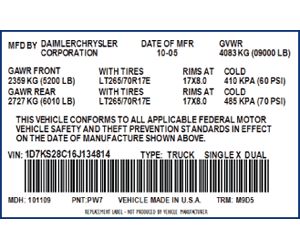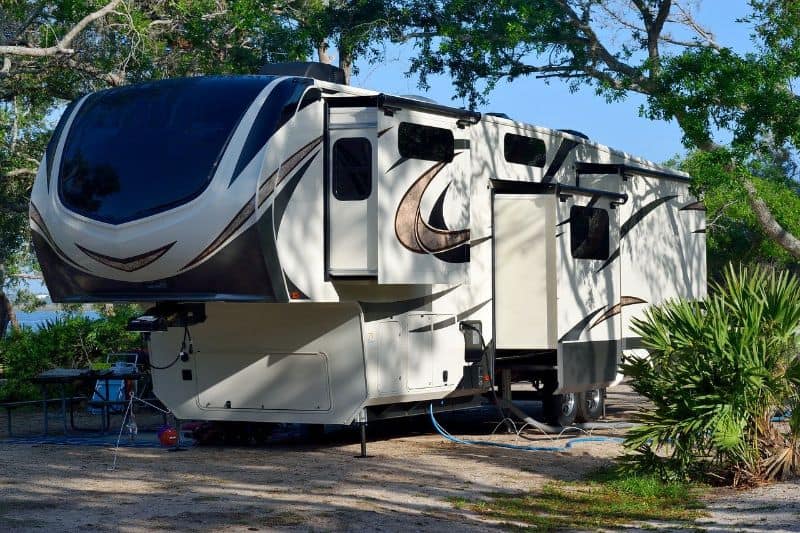This article doesn’t require any fancy introduction. This is a nuts-and-bolts kind of post. You want to know what the GVWR means for an RV, and I’m here to tell you!
Let’s get going.
What Is Your RV GVWR?
GVWR stands for Gross Vehicle Weight Rating,* and it’s one of the most important specifications of your RV.
*With towables, GVWR may be replaced with GTWR (Gross Trailer Weight Rating).
Simply put, when you place your camper or motorhome on a scale, it should never weigh more than the GVWR. No ifs, ands, or buts.
Contrary to popular belief, the GVWR is not necessarily the weight beyond which the RV will suffer immediate structural damage (although it might be). Instead, the GVWR is the maximum safe weight of the vehicle.
“Safe” can be determined several ways. More on this later.

Why Is My RV GVWR Important?
You want to know your GVWR for several reasons:
- The GVWR is (at least!) the amount of weight your tow vehicle should be able to tow.
- You need to know your GVWR when you weigh your RV to make sure it’s loaded safely. Otherwise, tire blowouts!
- Exceptionally large GVWRs may require special driver’s licenses or come with road restrictions.
- Exceptionally small GVWRs may be exempt from certain requirements, like electric brakes.
Where Can I Find My Trailer GVWR?
Your RV or trailer GVWR can be found in three places:
- Your MSO or Title
- Your Owner’s Manual
- Your VIN sticker

Can I Increase Or Modify My GVWR?
There is NEVER a scenario in which you are allowed to exceed the factory GVWR.
I don’t care what kind of weight-distribution hitch or equalizing suspension you have. I don’t care what kind of aftermarket modifications you’ve done, even if you’ve upgraded the axles.
The GVWR is carved in stone.
You weren’t part of the design team. You don’t know what the limiting factor was. Maybe you upgraded the axle, but the limiting factor was the tongue weld. Maybe you increased the tire size, but the limiting factor was braking performance or trailer sway. You simply cannot know all the design considerations that went into calculating the GVWR. The weakest link breaks the chain.
No matter what aftermarket modifications you make, you cannot increase the GVWR of an RV or trailer.
If you choose to ignore the GVWR, you do so at your own peril. You have officially (possibly irrevocably) overloaded your RV beyond what it was designed to carry, and you may damage the tongue, axle, tires, coupler, or other components. Or you may see deteriorating and dangerous vehicle performance, such as unacceptably long braking distances or broken transmissions.
In the case of an accident, you may be held liable because you exceeded the GVWR. RV manufacturers, Extended Service Contract providers, and insurance companies may deny you coverage because you used the RV outside of its intended use.
The GVWR is law.
It’s also useful to know what the GVWR is NOT.
- The GVWR is not the shipping weight [aka, factory weight or Unloaded Vehicle Weight (UVW)]. The shipping weight is the weight of the RV as delivered to the dealer by the factory. This must include the weight of full propane tanks and onboard water supply if equipped.
- The GVWR is not the GAWR (Gross Axle Weight Rating). The GAWR is how much weight can be borne by the axle assembly, and that’s determined by the axle manufacturer.
- The GVWR is not the cargo capacity. Cargo capacity is what’s left over after the curb weight of the RV (factory weight + propane + freshwater) has been subtracted from the GVWR. Some manufacturers include a battery in this; some don’t.
Who Decides the GVWR?
Some towable RV manufacturers design and fabricate their own chassis. Most do not. Most travel trailer frames are fabricated by Lippert or BAL, whereas there’s more diversity in 5th wheel frame fabricators.
Usually, whoever designs the chassis calculates and assigns the GVWR of the chassis. This is primarily based on A) the strength of the frame and B) the effective net GAWR* of the suspension system.
*For dual- and triple-axle RVs, the effective GAWR is usually, but not always, equal to the sum of the individual axle GAWR. It depends how the axles are equalized.
The final-stage manufacturer may choose to reduce the GVWR to less than what the chassis manufacturer allowed.
What Is the Average GVWR of an RV?
I’m afraid any answer I give you will be useless. The average GVWR of all RVs is a paperwork number that won’t help you shop in the real world.
Here are some more useful numbers:
- Most travel trailers are less than 10,000 lbs GVWR
- Most 5th wheels are less than 14,000 lbs GVWR
- Most motorhomes are less than 26,000 lbs GVWR
Back in 2021, I even calculated some numbers based on a survey of more than 200 RVs! I discovered that the average camper trailer weighs around 5,900 pounds empty and is about 26 feet long.
How Is a Trailer GVWR Calculated?

Federal law restricts how GVWR should be calculated. Per CFR 49 571.110 in the FMVSS:
S9.2 On RV trailers, the sum of the GAWRs of all axles on the vehicle plus the vehicle manufacturer’s recommended tongue weight must not be less than the GVWR. If tongue weight is specified as a range, the minimum value must be used.
In other words, you can’t overload the axles!!
For a towable RV, the math gets a little weird, because manufacturers are allowed to assume that some of the weight is on the tongue, not the axle.
RV manufacturers like that because they can squeeze extra cargo capacity out of a camper without upsizing the axle. And exercised reasonably, it’s a safe assumption.
However, Uncle Sam will only allow you to use the most conservative estimate. So for travel trailers, we assume 10% tongue weight, and for 5th wheels, we usually assume 15%.
Here’s an example with numbers.
- A travel trailer with two 5,200-lb equalized axles could have a GVWR of 5,200 x 2 / 0.9 = 11,555 lbs.*
- Meanwhile, a 5th wheel with two 5,200-lb equalized axles could have a GVWR of 5,200 x 2 / 0.85 = 12,235 lbs.
Notice how the 5th wheel has a larger GVWR, even though the axles are the same? That’s because the engineer assumes more weight on the 5th wheel is carried by the hitch.
(As I explained in my article on the “hidden danger” of weight-distribution hitches, this assumption can break down on a maximally loaded travel trailer.)
This simple equation (GVWR = Effective Gross Axle Weight Rating + Tongue Weight) is technically correct but realistically tenuous. There are a lot of hidden assumptions!
- The math assumes you’ll load your tongue properly. But if you don’t load your travel trailer properly, and you have <10% or <15% on the tongue, then you’ll have overloaded your axles by the time you max out your GVWR!
- The math assumes equal side-to-side weight distribution. This one in particular has gotten a lot of motorhome manufacturers in trouble. It is possible, depending on how you load your trailer, that the tires on one side could be overloaded, even if you’re within your GVWR!
P.S. Does an RV GVWR Include Hitch Weight?
This is a popular question about GVWR. In case my previous answer didn’t make sense (it’s a lot of engineering gobbledygook, I know), I’ll phrase it another way:
GVWR is the entire weight of your RV unattached to anything. So yes, the GVWR includes the hitch weight (aka tongue weight) as well.
How Is a Motorhome GVWR Calculated?

Federal law restricts how GVWR should be calculated. Per CFR 49 571.120 in the FMVSS:
S9.1 On motor homes, the sum of the gross axle weight ratings (GAWR) of all axles on the vehicle must not be less than the gross vehicle weight rating (GVWR).
In simple language, this means that the GVWR cannot exceed the sum total of all the axle GAWRs – under any circumstances!
You see, motorhome manufacturers don’t make their own chassis. Almost motorhomes – Class A’s, Class B’s, and Class C’s – are built on chassis sourced from automotive-style manufacturers like Freightliner, Spartan, Ram, Mercedes-Benz, and Ford.
The second-stage RV manufacturer does not calculate the chassis GVWR. The chassis manufacturer does. In some cases, the two will work closely together to settle on a mutually accepted GVWR, but the chassis manufacturer has the final say.
Here are several factors that go into calculating GVWR for a motorhome chassis. Here are some examples:
- How much weight the engine can haul (particularly per the SAE J2807 towing test)
- How much weight the structure can bear without unacceptable deflection or deformation
- How much weight the axle assembly can bear (struts, shocks, tires, brakes, bearings, etc.)
Just as the weakest link breaks the chain, so the weakest component determines the GVWR. Calculating the GVWR for a motorhome chassis is much more complicated than determining it for a towable camper frame.
The Ford F-53 stripped motorhome chassis, for instance, has a 16,000 to 20,500 lbs GVWR depending on the configuration.
This does NOT mean the RV manufacturer can add 16,000 to 20,500 lbs!
- For one, the RV manufacturer has to leave room leftover for cargo carrying capacity (CCC).
- For another, the RV manufacturer has to leave room for operational fluids, like propane, fuel, and freshwater.
- And most importantly, the GVWR includes the weight of the F-53 chassis itself!
If you’ve made it to the end of this article, great job! I know reading about GVWR and other acronyms isn’t super exciting (unless you’re an engineer, that is).
But if you want to avoid tire blowouts, broken couplers and damaged axles, then pay attention to your GVWR! It could save your life – and the life of everyone driving around you.
Leave a Reply